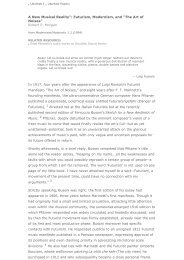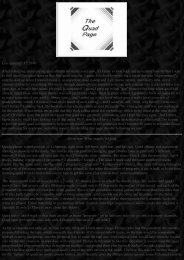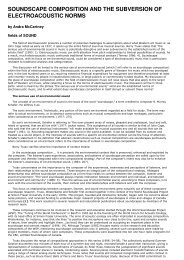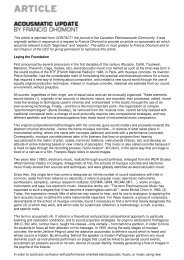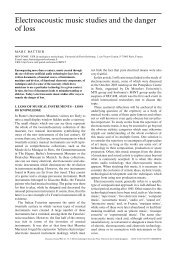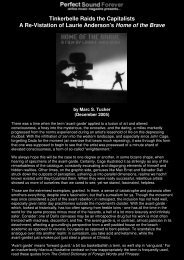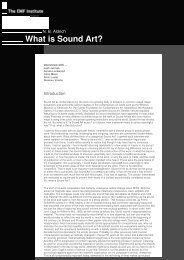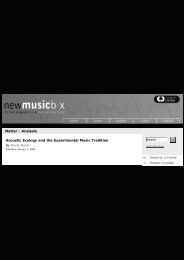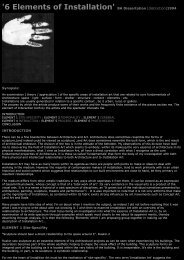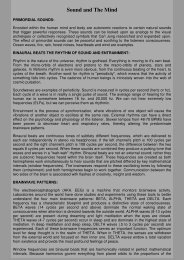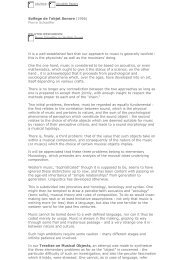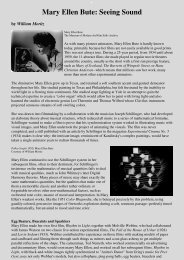Labelle-xxxx-Speaking Volumes.pdf - An International Archive of ...
Labelle-xxxx-Speaking Volumes.pdf - An International Archive of ...
Labelle-xxxx-Speaking Volumes.pdf - An International Archive of ...
- No tags were found...
You also want an ePaper? Increase the reach of your titles
YUMPU automatically turns print PDFs into web optimized ePapers that Google loves.
and flute sculptures (which respond to wind) to his kinetic sculptures<strong>of</strong> stone, wood bars, and motors, sound occurs through a relation toimmediate surroundings, as a live unfolding. His outdoor project forSutton Edge in Yorkshire (1991) consisted <strong>of</strong> bow-like woodensculptures planted in the ground with string stretched taut forming adiamond-shape suspended against the wind. The extremely sensitivesculptures vibrated and flexed in response to the wind, creatingrhythmic oscillations that carried across the hills. To listen then is toappreciate and follow sound as a residue <strong>of</strong> a natural event, whereobject and phenomena intertwine to give voice to an acousticalpresence. The Danish artist William Sørensen's furthers suchconversations.The 4 flapping sound-instruments placed on the dike facing southwest in the direction <strong>of</strong> the wind.Photo by William Louis Sørensen.Sørensen's Landing Ground for Waders (1983) installed in WestJylland (Denmark) consists <strong>of</strong> a series <strong>of</strong> structures built from basicmaterials: wine bottles arranged in rows and tilted to face the wind, orwood structures draped in thick plastic that billowed out in response tothe wind, flapping and rippling with sound. The environment functionsas a player whose instruments reveal a buried music, a soundscapealways just out <strong>of</strong> reach, yet ever-present.These examples <strong>of</strong> outdoor, public sound art projects build areciprocal relation to the real: materials are aligned with foundphenomena, objects are constructed as instruments played by thenatural environment, and recordings lend to a sense <strong>of</strong> renewedorientation, hinting at overcoming any discrepancy between silenceand noise through an appreciation <strong>of</strong> the harmonious. Yet such worksarrive at harmony by surprising perception - on some level, the workengages the listener by producing something new. Whetherpreviously unheard or distant, proto-cosmic or geological, sound isculled from the environment and pulled into the centre <strong>of</strong> attention,attracting the ear by being all too "out <strong>of</strong> place".To enrich the experience <strong>of</strong> listening and an appreciation to theenvironment, on some level enacts a form <strong>of</strong> intrusion onto thatenvironment. Countering the intended coupling <strong>of</strong> listener andenvironment in harmonious caress, the potential that I want to focuson arrives through an unexpected relation to the harmonious, whichmay result in outcry rather than acceptance. To focus on this otherpart, the part that may go unheard, is to register sound's culturalweight by signifying not only through sensation or pure perception, butby a meaning found in the verbalization <strong>of</strong> abuse or appearance <strong>of</strong>vandalism.



